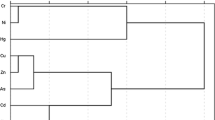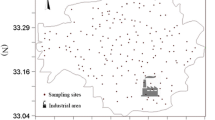Abstract
The Republic of Azerbaijan suffers from low agricultural productivity caused by soil salinization and erosion, and limited and insufficient soil data are available for economic and political reasons. In this study, soil salinity and heavy metal levels were assessed. Environmental risk assessment was conducted to evaluate the potential risk posed by soils to human health. Soil guideline values were proposed to monitor soil pollution in the Republic of Azerbaijan. Water extraction and spatial variability analysis were conducted to understand soil salinization and heavy metal pollution. Among the 20 studied elements, the elements Ca, Cl, and S and the heavy metals Cr, Ni, and Pb were classified as problematic on the basis of the geoaccumulation index, and As was also identified as posing a possible risk on the basis of the potential ecological risk index. Based on the developed soil guideline values for agricultural soil, the As, Cr, and Ni in the soil samples exceeded their respective guidelines by 31.3, 41.8, and 61.6%, respectively. Water extraction results confirmed that 99% of the leached ions were cationic salts, and the most problematic ion was Na, followed by Ca, Cl, and S. The extractability values of Cr and Ni were significantly lower than those of other heavy metals, which implies that their actual leaching potential may be overestimated. The linear regression and spatial variability analysis confirmed that leachable salts have accumulated in lowland areas due to the capillary rise of water and evaporation, but the distribution of heavy metals confirmed that As, Cr, and Ni were abundant in agricultural soils. Our results clearly showed that heavy metal soil contamination and high salinity levels are major problems that should be considered when assessing food safety and health hazards in the Mugan Plain of Azerbaijan. Therefore, future studies should be performed for additional environmental risk assessment, detailed hazard identification, and health risk assessment.





Similar content being viewed by others
References
Abedi, M. J., & Talibudeen, O. (1974). The calcareous soils of Azerbaijan. I. Catena development related to the distribution and surface properties of soil carbonate. Journal of Soil Science, 25(3), 357–372. https://doi.org/10.1111/j.1365-2389.1974.tb01132.x.
Alloway, B. (1995). Heavy metals in soils trace metals and metalloids in soils and their bioavailability. Heavy Metals in Soils: trace metals and metalloids in soils and their bioavailability. https://doi.org/10.1007/9789400744707.
Babaev, M. P., Gurbanov, E. A., & Ramazanova, F. M. (2015). Main types of soil degradation in the Kura-Aras Lowland of Azerbaijan. Eurasian Soil Science, 48(4), 445–456. https://doi.org/10.1134/s106422931504002x.
Bakradze, E., Vodyanitskii, Y., Urushadze, T., Chankseliani, Z., & Arabidze, M. (2018). About rationing of the heavy metals in soils of Georgia. Annals of Agrarian Science, 16(1), 1–6. https://doi.org/10.1016/j.aasci.2017.09.002.
Bartier, P. M., & Keller, C. P. (1996). Multivariate interpolation to incorporate thematic surface data using inverse distance weighting (IDW). Computers and Geosciences, 22(7), 795–799. https://doi.org/10.1016/0098-3004(96)00021-0.
Boularbah, A., Schwartz, C., Bitton, G., & Morel, J. L. (2006). Heavy metal contamination from mining sites in South Morocco: 1. Use of a biotest to assess metal toxicity of tailings and soils. Chemosphere, 63(5), 802–810. https://doi.org/10.1016/j.chemosphere.2005.07.079.
Bowen, H. J. M. (1979). Environmental chemistry of the elements. Environmental chemistry of the elements. https://www.cabdirect.org/cabdirect/abstract/19800700395. Accessed 5 August 2019.
Cappuyns, V., & Swennen, R. (2008). The use of leaching tests to study the potential mobilization of heavy metals from soils and sediments: a comparison. Water, Air, and Soil Pollution, 191(1–4), 95–111. https://doi.org/10.1007/s11270-007-9609-4.
Cavanagh, J.-A. E., & Munir, K. (2016). Development of soil guideline values for the protection of ecological receptors (Eco-SGVs): technical document. http://www.envirolink.govt.nz/assets/Envirolink/R10-420Development20of20soil20guideline20values20for20the20protection20of20ecological20receptors20-20Technical20document.pdf
Claudio, C., Di Iorio, E., Liu, Q., Jiang, Z., & Barrón, V. (2017). Iron oxide nanoparticles in soils: environmental and agronomic importance. Journal of Nanoscience and Nanotechnology, 17(7), 4449–4460. https://doi.org/10.1166/jnn.2017.14197.
Daliakopoulos, I. N., Tsanis, I. K., Koutroulis, A., Kourgialas, N. N., Varouchakis, A. E., Karatzas, G. P., & Ritsema, C. J. (2016). The threat of soil salinity: A European scale review. Science of the Total Environment, 573, 727–739. https://doi.org/10.1016/j.scitotenv.2016.08.177.
Davis, A., Ruby, M., & Bergstrom, P. (1992). Bioavailability of arsenic and lead in soils from the Butte, Montana, mining district. Environmental Science & …, 26(3), 461–468. http://pubs.acs.org/doi/abs/10.1021/es00027a002. Accessed 5 August 2014.
Emadi, M., & Baghernejad, M. (2014). Comparison of spatial interpolation techniques for mapping soil pH and salinity in agricultural coastal areas, northern Iran. Archives of Agronomy and Soil Science, 60(9), 1315–1327. https://doi.org/10.1080/03650340.2014.880837.
FAO. (2014). World reference base for soil resources 2014. International soil classification system for naming soils and creating legends for soil maps. World Soil Resources Reports No. 106. https://doi.org/10.1017/S0014479706394902
Fernández, M. M. D., Cagigal, E., Vega, M. M. M., Urzelai, A., Babín, M., Pro, J., & Tarazona, J. V. (2005). Ecological risk assessment of contaminated soils through direct toxicity assessment. Ecotoxicology, 62(2), 174–184. https://doi.org/10.1016/j.ecoenv.2004.11.013.
Feyziyev, F., Babayev, M., Priori, S., & L’Abate, G. (2016). Using visible-near infrared spectroscopy to predict soil properties of Mugan Plain, Azerbaijan. Open Journal of Soil Science, 06(03), 52–58. https://doi.org/10.4236/ojss.2016.63006.
Frouz, J., Hrčková, K., Lána, J., & Krištůfek, V. (2011). Can laboratory toxicity tests explain the pattern of field communities of algae, plants, and invertebrates along a toxicity gradient of post-mining sites? Applied Soil …, 51(1), 114–121. https://doi.org/10.1016/j.apsoil.2011.09.007.
Ghrefat, H. a., Abu-Rukah, Y., & Rosen, M. a. (2011). Application of geoaccumulation index and enrichment factor for assessing metal contamination in the sediments of Kafrain Dam, Jordan. Environmental Monitoring and Assessment, 178(1–4), 95–109. https://doi.org/10.1007/s10661-010-1675-1.
Goverment of The Republic of Azerbaijan. (2014). National Atlas of the Republic of Azerbaijan.
Hakanson, L. (1980). An ecological risk index for aquatic pollution control.a sedimentological approach. Water Research, 14(8), 975–1001. https://doi.org/10.1016/0043-1354(80)90143-8.
Han, J., & Ro, H. M. (2018). Interpreting competitive adsorption of arsenate and phosphate on nanosized iron (hydr)oxides: effects of pH and surface loading. Environmental Science and Pollution Research, 25(28), 28572–28582. https://doi.org/10.1007/s11356-018-2897-y.
Han, J., Kim, J., Kim, M., Moon, D. H., Sung, J.-S., & Hyun, S. (2014). Chemical extractability of As and Pb from soils across long-term abandoned metallic mine sites in Korea and their phytoavailability assessed by Brassica juncea. Environmental Science and Pollution Research International, 22(2), 1270–1278. https://doi.org/10.1007/s11356-014-3441-3.
Han, J., Kim, M., & Ro, H. M. (2020). Factors modifying the structural configuration of oxyanions and organic acids adsorbed on iron (hydr)oxides in soils. A review. Environmental Chemistry Letters, 18(3), 631–662. https://doi.org/10.1007/s10311-020-00964-4.
Hommels, A., Scholte, K. H., Munoz-Sabater, J., Hanssen, R. F., Van der Meer, F. D., Kroonenberg, S. B., et al. (2003). Preliminary ASTER and INSAR imagery combination for mud volcano dynamics, Azerbaijan. IGARSS 2003. 2003 IEEE International Geoscience and Remote Sensing Symposium. Proceedings (IEEE Cat. No.03CH37477), 3(May), 1573–1575. https://doi.org/10.1109/IGARSS.2003.1294179
Janoš, P., Vávrová, J., Herzogová, L., & Pilařová, V. (2010). Effects of inorganic and organic amendments on the mobility (leachability) of heavy metals in contaminated soil: a sequential extraction study. Geoderma, 159(3–4), 335–341. https://doi.org/10.1016/j.geoderma.2010.08.009.
Jiang, X., Lu, W. X., Zhao, H. Q., Yang, Q. C., & Yang, Z. P. (2014). Potential ecological risk assessment and prediction of soil heavy-metal pollution around coal gangue dump. Natural Hazards and Earth System Sciences, 14(6), 1599–1610. https://doi.org/10.5194/nhess-14-1599-2014.
Jönsson, J., & Sherman, D. M. (2008). Sorption of As(III) and As(V) to siderite, green rust (fougerite) and magnetite: Implications for arsenic release in anoxic groundwaters. Chemical Geology, 255(1–2), 173–181. https://doi.org/10.1016/j.chemgeo.2008.06.036.
Khalilova, H., & Mammadov, V. (2016). Assessing the anthropogenic impact on heavy metal pollution of soils and sediments in urban areas of Azerbaijan’s oil industrial region. Polish Journal of Environmental Studies, 25(1), 159–166. https://doi.org/10.15244/pjoes/60723.
Kim, E. J., Yoo, J.-C., & Baek, K. (2014). Arsenic speciation and bioaccessibility in arsenic-contaminated soils: sequential extraction and mineralogical investigation. Environmental pollution (Barking, Essex : 1987), 186, 29–35. https://doi.org/10.1016/j.envpol.2013.11.032.
Li, Y., Wang, X., & Wang, J. (2012). Cation exchange, interlayer spacing, and thermal analysis of Na/Ca-montmorillonite modified with alkaline and alkaline earth metal ions. Journal of Thermal Analysis and Calorimetry, 110(3), 1199–1206. https://doi.org/10.1007/s10973-011-2109-1.
Müller, G. (1979). Schwermetalle in den Sedimenten des Rheins—Veränderungen seit 1971. Umschau, 24, 778–783.
Oglu, A. Z. H. (2018). Agriculture in Azerbaijan and its development prospects. International Journal of Medical and Biomedical Studies, 2(4), 79–91. https://doi.org/10.32553/ijmbs.v2i4.37.
Sakadevan, K., & Nguyen, M.-L. (2010). Extent, impact, and response to soil and water salinity in arid and semiarid regions. Advances in Agronomy (Vol. 109). Elsevier Ltd. https://doi.org/10.1016/B978-0-12-385040-9.00002-5.
Station, R. E. (1992). Chemical extractability of heavy metals during and after long-term applications of sewage sludge to soil, 313–321.
Tessier, A., Campbell, P., & Bisson, M. (1979). Sequential extraction procedure for the speciation of particulate trace metals. Analytical Chemistry, 51(7), 844–851 http://pubs.acs.org/doi/abs/10.1021/ac50043a017. .
Tóth, G., Hermann, T., Da Silva, M. R., & Montanarella, L. (2016). Heavy metals in agricultural soils of the European Union with implications for food safety. Environment International, 88, 299–309. https://doi.org/10.1016/j.envint.2015.12.017.
Towett, E. K., Shepherd, K. D., Tondoh, J. E., Winowiecki, L. A., Lulseged, T., Nyambura, M., Sila, A., Vågen, T. G., & Cadisch, G. (2015). Total elemental composition of soils in Sub-Saharan Africa and relationship with soil forming factors. Geoderma Regional, 5, 157–168. https://doi.org/10.1016/j.geodrs.2015.06.002.
Vodyanitskii, Y. N., Minkina, T. M., Kubrin, S. P., Pankratov, D. A., & Fedorenko, A. G. (2019). Common and rare iron, sulfur, and zinc minerals in technogenically contaminated hydromorphic soil from Southern Russia. Environmental Geochemistry and Health, 6. https://doi.org/10.1007/s10653-019-00295-6
Yang, F., Zhang, G., Yin, X., & Liu, Z. (2011). Field-scale spatial variation of saline-sodic soil and its relation with environmental factors in Western Songnen Plain of China. International Journal of Environmental Research and Public Health, 8(2), 374–387. https://doi.org/10.3390/ijerph8020374.
Acknowledgments
We appreciate all participants in this collaborative research from the SEBA Seoul-Baku Korea-Azerbaijan Cultural Exchange Association (President Ruhangiz Heydarov), National Academy of Science of Azerbaijan (NASA), Korea International Cooperation Agency (KOICA), and Korean embassy in the Republic of Azerbaijan (Ambassador Chang Gyu Kim). We especially thank the members (Khidir Gasimov and Djavidan Guliyev for soil sampling; Gani Gasimov, Konul Aliyeva, Konul Gafarbeyli, Narmin Najafova and Gunel Mammadova for analyzing samples; Baxtiyar Haqverdiyev for interpreting languages.) of the International Soil Science and Ecology Laboratory established by the collaboration between the College of Agricultural and Life Science of Seoul National University and the Institute of Soil Science and Agrochemistry of NASA.
Availability of data and materials
The data set of fundamental soil characteristics (pH, EC, GPS, coordinates and elevation) and the elemental concentrations determined by XRF and ICP-OES are available upon request from the corresponding author through email (hmro@snu.ac.kr).
Funding
This research was planned and conducted under the Official Development Assistance (ODA) program of the Republic of Korea. This research was supported not only by the Science and Technology Support Program (NRF-2016K1A3A9A01913914) and Young Researcher Program (NRF-2019R1C1C1007535) through National Research Foundation of Korea (NRF) grants funded by the Korean government (MSIP and MOE) but also by the Brain Korea 21 Plus Program funded by the Korean government (MOE).
Author information
Authors and Affiliations
Contributions
Junho Han: conceptualization, methodology, formal analysis, data curation, writing—original draft; Zaman Mammadov: investigation, resources, project administration; Minhee Kim: data curation, formal analysis; Elton Mammadov: resources, visualization; Seoyeon Lee: methodology, validation; Jisuk Park: project administration; Garib Mammadov: project administration, resources; Guliyev Elovsat: project administration, funding acquisition; Hee-Myong Ro: writing—review and editing, supervision, funding acquisition
Corresponding author
Ethics declarations
Conflict of interest
The authors declare that they have no conflicts of interest.
Additional information
Publisher’s note
Springer Nature remains neutral with regard to jurisdictional claims in published maps and institutional affiliations.
Supplementary information
ESM 1
(DOCX 9296 kb)
Rights and permissions
About this article
Cite this article
Han, J., Mammadov, Z., Kim, M. et al. Spatial distribution of salinity and heavy metals in surface soils on the Mugan Plain, the Republic of Azerbaijan. Environ Monit Assess 193, 95 (2021). https://doi.org/10.1007/s10661-021-08877-7
Received:
Accepted:
Published:
DOI: https://doi.org/10.1007/s10661-021-08877-7




